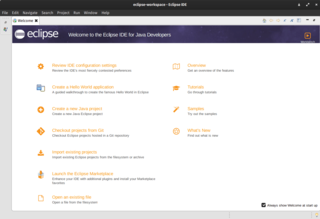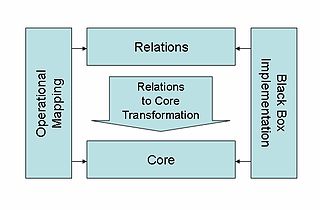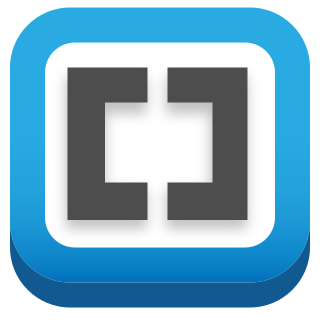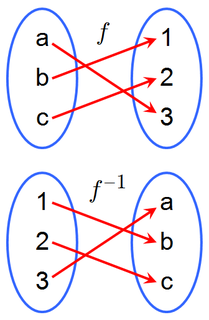XSLT is a language for transforming XML documents into other XML documents, or other formats such as HTML for web pages, plain text or XSL Formatting Objects, which may subsequently be converted to other formats, such as PDF, PostScript and PNG. XSLT 1.0 is widely supported in modern web browsers.
In computer science, digital image processing is the use of computer algorithms to perform image processing on digital images. As a subcategory or field of digital signal processing, digital image processing has many advantages over analog image processing. It allows a much wider range of algorithms to be applied to the input data and can avoid problems such as the build-up of noise and signal distortion during processing. Since images are defined over two dimensions digital image processing may be modeled in the form of multidimensional systems.

Eclipse is an integrated development environment (IDE) used in computer programming, and in 2014 was the most widely used Java IDE in one website's poll. It contains a base workspace and an extensible plug-in system for customizing the environment. Eclipse is written mostly in Java and its primary use is for developing Java applications, but it may also be used to develop applications in other programming languages via plug-ins, including Ada, ABAP, C, C++, C#, Clojure, COBOL, D, Erlang, Fortran, Groovy, Haskell, JavaScript, Julia, Lasso, Lua, NATURAL, Perl, PHP, Prolog, Python, R, Ruby, Rust, Scala, and Scheme. It can also be used to develop documents with LaTeX and packages for the software Mathematica. Development environments include the Eclipse Java development tools (JDT) for Java and Scala, Eclipse CDT for C/C++, and Eclipse PDT for PHP, among others.

In computing, extract, transform, load (ETL) is the general procedure of copying data from one or more sources into a destination system which represents the data differently from the source(s) or in a different context than the source(s). The ETL process became a popular concept in the 1970s and is often used in data warehousing.
Round-trip engineering (RTE) is a functionality of software development tools that synchronizes two or more related software artifacts, such as, source code, models, configuration files, and even documentation. The need for round-trip engineering arises when the same information is present in multiple artifacts and therefore an inconsistency may occur if not all artifacts are consistently updated to reflect a given change. For example, some piece of information was added to/changed in only one artifact and, as a result, it became missing in/inconsistent with the other artifacts.

Real-time computer graphics or real-time rendering is the sub-field of computer graphics focused on producing and analyzing images in real time. The term can refer to anything from rendering an application's graphical user interface (GUI) to real-time image analysis, but is most often used in reference to interactive 3D computer graphics, typically using a graphics processing unit (GPU). One example of this concept is a video game that rapidly renders changing 3D environments to produce an illusion of motion.
In a database, a view is the result set of a stored query on the data, which the database users can query just as they would in a persistent database collection object. This pre-established query command is kept in the database dictionary. Unlike ordinary base tables in a relational database, a view does not form part of the physical schema: as a result set, it is a virtual table computed or collated dynamically from data in the database when access to that view is requested. Changes applied to the data in a relevant underlying table are reflected in the data shown in subsequent invocations of the view. In some NoSQL databases, views are the only way to query data.

ATL is a model transformation language and toolkit developed and maintained by OBEO and AtlanMod. It was initiated by the AtlanMod team. In the field of Model-Driven Engineering (MDE), ATL provides ways to produce a set of target models from a set of source models.

QVT (Query/View/Transformation) is a standard set of languages for model transformation defined by the Object Management Group.
A model transformation, in model-driven engineering, is an automated way of modifying and creating models. An example use of model transformation is ensuring that a family of models is consistent, in a precise sense which the software engineer can define. The aim of using a model transformation is to save effort and reduce errors by automating the building and modification of models where possible.
Knowledge Discovery Metamodel (KDM) is a publicly available specification from the Object Management Group (OMG). KDM is a common intermediate representation for existing software systems and their operating environments, that defines common metadata required for deep semantic integration of Application Lifecycle Management tools. KDM was designed as the OMG's foundation for software modernization, IT portfolio management and software assurance. KDM uses OMG's Meta-Object Facility to define an XMI interchange format between tools that work with existing software as well as an abstract interface (API) for the next-generation assurance and modernization tools. KDM standardizes existing approaches to knowledge discovery in software engineering artifacts, also known as software mining.
LightZone is a free, open-source digital photo editor software application. It was originally developed as commercial software by the now-defunct Light Crafts. Its main purpose is to handle the workflow, including non-destructive editing when handling images in various RAW formats. It is comparable to Adobe Lightroom.
In business, master data management (MDM) is a method used to define and manage the critical data of an organization to provide, with data integration, a single point of reference. The data that is mastered may include reference data - the set of permissible values, and the analytical data that supports decision making.
Microsoft's Text Template Transformation Toolkit is a template based text generation framework included with Visual Studio. T4 source files are usually denoted by the file extension ".tt".

Metamaterial cloaking is the usage of metamaterials in an invisibility cloak. This is accomplished by manipulating the paths traversed by light through a novel optical material. Metamaterials direct and control the propagation and transmission of specified parts of the light spectrum and demonstrate the potential to render an object seemingly invisible. Metamaterial cloaking, based on transformation optics, describes the process of shielding something from view by controlling electromagnetic radiation. Objects in the defined location are still present, but incident waves are guided around them without being affected by the object itself.
Bitemporal Modeling is a specific case of Temporal database information modeling technique designed to handle historical data along two different timelines. This makes it possible to rewind the information to "as it actually was" in combination with "as it was recorded" at some point in time. In order to be able to do so, information cannot be discarded even if it is erroneous. Within, for example, financial reporting it is often desirable to be able to recreate an old report both as it actually looked at the time of creation and as it should have looked given corrections made to the data after its creation.
Knockout is a standalone JavaScript implementation of the Model-View-ViewModel pattern with templates. The underlying principles are therefore:

Brackets is a source code editor with a primary focus on web development. Created by Adobe Systems, it is free and open-source software licensed under the MIT License, and is currently maintained on GitHub by Adobe and other open-source developers. It is written in JavaScript, HTML and CSS. Brackets is cross-platform, available for macOS, Windows, and most Linux distributions. The main purpose of brackets is its live HTML, CSS and JavaScript editing functionality.
Gyroscope is an open source PHP framework and a code template system for building web backend systems. Gyroscope uses a specific and yet flexible user interaction model to reveal and explore the inner-relations of a database.







